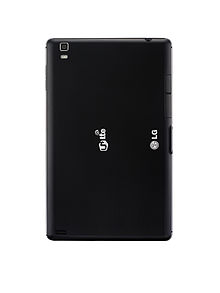LG Optimus Pad LTE
 | |
| Manufacturer | LG Electronics |
|---|---|
| Product family | LG Optimus |
| Type | Tablet media player |
| Release date | January 2012 (KR) |
| Operating system | Android 3.2 "Honeycomb" may upgradable to Android 4.1.2 "Jelly Bean" |
| CPU | 1.5 GHz Qualcomm dual-core processor |
| Storage | Flash memory: 32 GB |
| Display | 8.9 in (23 cm) 1280×768 px at 168 ppi |
| Input | Multi-touch capacitive touchscreen display 3-axis gyroscope 3-axis accelerometer Digital compass Ambient light sensor |
| Camera | 8.0 megapixel rear-facing 3D camera with LED Flash and 1080p video capture 2.0 megapixel front-facing camera |
| Connectivity | Wi-Fi 802.11b/g/n and Bluetooth 2.1+EDR |
| Power | 6800 mAh |
| Dimensions | 243 mm (9.6 in) (h) 149.4 mm (5.88 in) (w) 12.8 mm (0.50 in) (d) |
| Mass | 630 g (22 oz) |
| Predecessor | LG Optimus Pad |
| Successor | LG G Pad 8.3 |
| Website | Optimus Pad LTE website |
The LG Optimus Pad LTE is a tablet computer developed by LG Electronics as a direct successor to the original LG Optimus Pad released in South Korea in January 2012.[1] The LG Optimus Pad LTE was planned to be released worldwide but was cancelled due to its lackluster sales in its domestic market and mixed-to-negative reception towards the device leaving LG to withdraw in the tablet making for a brief period in the world market before the release of its successor the LG G Pad 8.3.[2][3]
Features
The LG Optimus Pad LTE has a 2MP front-facing camera and a 8MP rear-facing camera. Like its predecessor, it features an 8.9-inch touchscreen that includes Wi-Fi 802.11b/g/n and Bluetooth 2.1 and is powered by a 6800 mAh Li-Ion which runs on a 1.5 GHz Qualcomm dual-core chipset and Android 3.2 Honeycomb with Optimus UI . And may upgradable to Android 4.1.2 Jelly Bean with CyanogenMod and Optimus UI
See also
- LG Optimus Pad The predecessor to the LG Optimus Pad LTE
- LG G Pad 8.3 The successor to the LG Optimus Pad LTE
References
- ^ Lutz, Zachary (17 January 2012). "LG makes Optimus Pad LTE official, 8.9-inch IPS tablet coming first to South Korea". Engadget. Retrieved 3 November 2013.
- ^ Savov, Vlad (19 June 2012). "LG putting tablets 'on the back burner,' focusing on smartphones". The Verge. Retrieved 3 November 2013.
- ^ Schoon, Robert (9 August 2013). "LG Optimus Pad Successor: LG G Pad Seen Under Review By Bluetooth SIG". Latino Post. Retrieved 3 November 2013.
- v
- t
- e
- Archos
- Archos 5 (Archos Generation 6)
- Archos 5 (Archos Generation 7)
- Archos 43
- Archos 70
- Archos 101
- Asus
- Eee Pad Transformer (TF101)
- Eee Pad Transformer Prime (TF201)
- Transformer Pad (TF300T)
- Transformer Pad Infinity (TF700T)
- Transformer Pad TF701T
- Nexus 7
- 2012 version
- 2013 version
- Barnes & Noble
- Nook Color
- Nook Tablet
- Nook HD/HD+
- Samsung Galaxy Tab 4 Nook
- BQ
- Aquaris M10
- DataWind
- Aakash
- Pixel C
- HP
- Slate 7
- Slate 21
- HTC
- Flyer/EVO View 4G
- Jetstream
- Nexus 9
- Huawei
- Mediapad M5
- JadooTV
- JadooTab
- JPay
- JP4
- JP5
- JP6
- Kobo
- Arc
- LeapFrog
- Epic
- Lenovo
- IdeaPad series
- ThinkPad Tablet
- LG
- Optimus Pad
- LTE
- G Pad
- MobyMax
- MobyMax Tablet
- Motorola
- Xoom
- Xyboard
- Nokia
- N1
- Notion Ink
- Adam tablet
- NVIDIA
- Shield Tablet
- Pakistan Aeronautical Complex
- PAC-PAD 1
- PAC-PAD Takhti 7
- PocketBook
- IQ 701
- A 10"
- Samsung
- Galaxy Tab series
- Galaxy Tab 2
- Galaxy Tab 3
- Galaxy Tab 4
- Galaxy Tab Pro
- Galaxy Tab S
- Galaxy Tab A
- Galaxy Tab E
- Galaxy Note series
- Galaxy Note Pro
- Nexus 10
- Sony
- Sony Tablet
- Xperia Tablet
- Android smartphones
- Other Android devices
- List of features in Android











